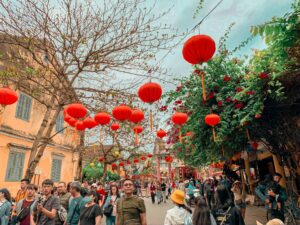The Lunar New Year, also known as the Chinese New Year, is an annual holiday that incorporates age-old traditions and celebrations in honor of the beginning of a new, lunar year. These customs are embraced throughout many parts of the world, although the exact date of festivities changes each year. In 2023, the Lunar New Year was celebrated on January 22nd; however, the date can fall anywhere between January 21st and February 20th. With nearly 1.5 billion people celebrating the occasion each year, it is an important event to highlight within your organization to forge a diverse, multi-language and inclusive culture. Offering Lunar New Year greetings is a simple solution to ensure that everyone feels welcome and understood.
Inquire now about Chinese document translation services or connect with a live Chinese interpreter.
Table of Contents
How is the Lunar New Year Celebrated?

Each year, those who celebrate the Lunar New Year gather among friends and family to reflect on the previous year while looking ahead to the start of a new one. Throughout China, the holiday is a time of rest for the entire country. Businesses are closed and those who have been out of town return home to engage in beloved traditions. During this period, celebrators rely heavily upon symbolism and the color red. Homes are decorated with red lanterns, paper cutouts, and other decorations in hopes of attracting good luck and prosperity in the year to come. Streets throughout the country are lined with banners, and many choose to dress in red.
The festivities are plentiful and varied and often incorporate an animal that corresponds to the Chinese zodiac. For instance, this year is “The Year of the Rabbit”, so many will incorporate rabbits. Children throughout Asia are gifted red envelopes filled with money, known as “lai see”. These are given by the older generations as a symbol of love, respect, and luck for the next year of their lives. Parades are filled with traditional Chinese dragons and lions, firework displays are plentiful, and feasts feature carefully selected items to attract the good and ward off the bad. All in all, the Lunar New Year is a time for friends, family, reflection, relaxation, and looking ahead to the future.
Common Lunar New Year Greetings
When the Lunar New Year arrives, it likely means that employees, business partners, clients, or other contacts of east Asian descent are out of the office during this timeframe, as they gather with friends and family to celebrate. Although a simple gesture, acknowledging the holiday and their culture goes a long way. Sending a Lunar New Year’s greeting, translated from English to Chinese, for instance, drastically improves your organization’s commitment to cultural diversity and inclusion. Some of the most common Lunar New Year greetings in English include:
- Happy Chinese New Year
- Good Health
- Surplus and Abundance Year After Year
- Or simply:
- Happy New Year
Translated Lunar New Year Greetings: The Year of the Rabbit
Sending a unique correspondence that includes a translated Lunar New Year greeting should follow the same sentiments as western culture holiday greetings. It is a time to express gratitude and wish recipients the best of luck in the year to come. Need help expressing these sentiments or ensuring that they are localized for a specific region? Give our corporate New Year greeting translation tool a try or inquire now to discuss how to translate documents from English to Chinese.